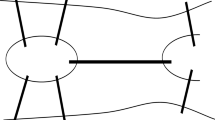Abstract
The article evaluates the Domain Postulate of the Classical Model of Science and the related Aristotelian prohibition rule on kind-crossing as interpretative tools in the history of the development of mathematics into a general science of quantities. Special reference is made to Proclus’ commentary to Euclid’s first book of Elements, to the sixteenth century translations of Euclid’s work into Latin and to the works of Stevin, Wallis, Viète and Descartes. The prohibition rule on kind-crossing formulated by Aristotle in Posterior analytics is used to distinguish between conceptions that share the same name but are substantively different: for example the search for a broader genus including all mathematical objects; the search for a common character of different species of mathematical objects; and the effort to treat magnitudes as numbers.
Similar content being viewed by others
References
Aristotle. Analytica posteriora. J. Barnes (Trans.) (1994). Posterior analytics. Oxford: Clarendon Press.
Bos H. (2001) Redefining geometrical exactness. Descartes’ transformation of the early modern concept of construction. Springer, New York
Cantù, P. (2003). La matematica da scienza delle grandezze a teoria delle forme. L’ Ausdehnungslehre di H. Graßmann. Dissertation, Università degli Studi di Genova.
Cantù, P. (2008). Mathematik als Größenlehre. In J. Stolzenberg & O.-P. Rudolph (Eds.), Christian Wolff und die europäische Aufklärung. Akten des 1. Internationalen Wolff-Kongresses, Teil IV. Mathematik und Naturwissenschaften. Ästhetik und Poetik, Halle a.d.S., 4–8 April 2004. (pp. 13–24). Hildesheim/Zürich/New York: Olms.
Crapulli G. (1969). Mathesis universalis. Genesi di un’idea nel XVI secolo. Roma: Edizioni dell’Ateneo.
de Jong, W. R., & Betti, A. (2008). The Classical Model of Science: A millennia-old model of scientific rationality. Synthese. doi:10.1007/s11229-008-9417-4.
Descartes, R. (1701). Regulae ad directionem ingenii. In Opuscula postuma, physica et mathematica. Amsterdam: Blaeu. Reprinted in G. Crapulli, Ed., (1966). La Haye: Nijhoff.
Euclid. (1883–1888). In J. L. Heiberg (Ed.), Elementa. Leipzig: Teubner. T. L. Heath (Trans.) (1956). The thirteen books of Euclid’s Elements. New York: Dover.
Klein J. (1968) Greek mathematical thought and the origin of algebra. MIT Press, Cambridge, Mass
Proclus. (1873). In G. Friedlein (Ed.), Commentarium in primum Euclidis Elementorum librum. Leipzig: Teubner. G. R. Morrow (Trans.) (1970). A commentary on the first book of Euclid’s Elements. Princeton, NJ: Princeton University Press.
Stevin, S. (1585). L’Arithmétique. Leyde: Plantin. Reprinted in E. J. Dijksterhuis et al. (Eds.), The principal works of Simon Stevin. Vol. II: Mathematics (1958, pp. 488–507). Amsterdam: Swets & Zeitlinger.
Viète, F. (1591). In artem analyticen Isagoge. Tours: Mettayer. Reprinted in F. van Schooten (Ed.), Francisci Vietae Opera mathematica (1646). Leiden: Elzevier. Reprinted Hildesheim/Zürich/New York: Olms (1970).
Wallis, J. (1657). Mathesis universalis. Oxford: Robinson. Reprinted in Opera (1695). Vol. I. Oxford: Thearto Sheldoniano. Reprinted Hildesheim/New York: Olms (1972).
Author information
Authors and Affiliations
Corresponding author
Rights and permissions
About this article
Cite this article
Cantù, P. Aristotle’s prohibition rule on kind-crossing and the definition of mathematics as a science of quantities. Synthese 174, 225–235 (2010). https://doi.org/10.1007/s11229-008-9419-2
Received:
Accepted:
Published:
Issue Date:
DOI: https://doi.org/10.1007/s11229-008-9419-2




